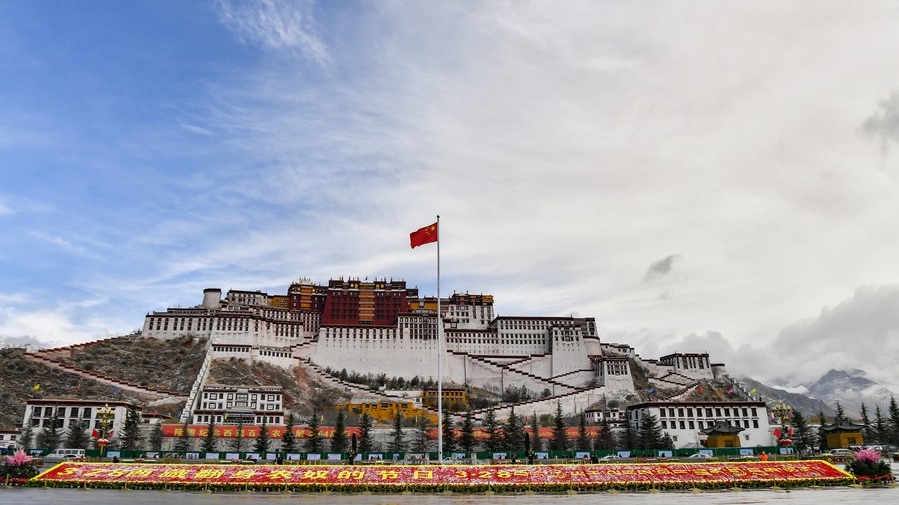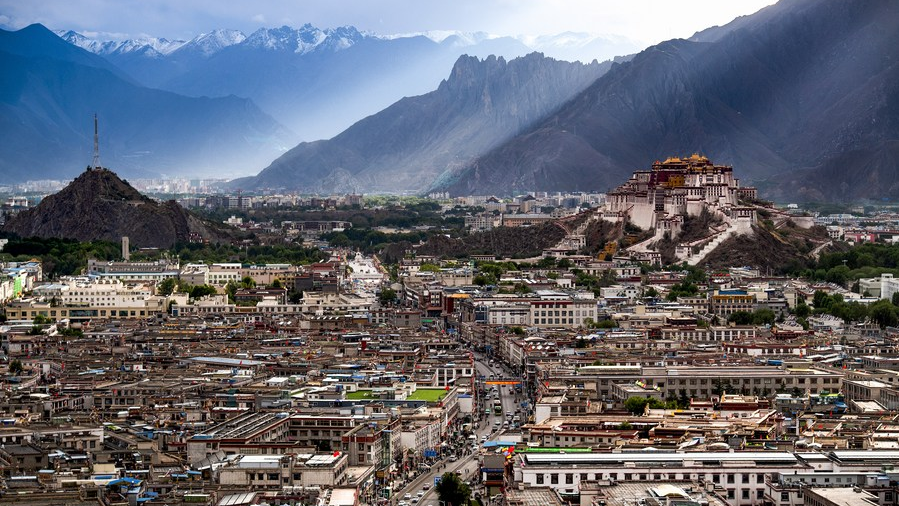
The Potala Palace is pictured on the occasion of the 15th Serfs' Emancipation Day in Lhasa, capital of southwest China's Xizang Autonomous Region, March 28, 2023. /Xinhua
The Potala Palace is pictured on the occasion of the 15th Serfs' Emancipation Day in Lhasa, capital of southwest China's Xizang Autonomous Region, March 28, 2023. /Xinhua
Editor's note: Xin Ping is a commentator on international affairs, writing regularly for Xinhua News Agency, CGTN, Global Times, China Daily, etc. The article reflects the author's views and not necessarily those of CGTN.
From sacred lakes to luxuriant highland barley fields, from sun-bathed, snow-capped mountains to bustling bazaars of Lhasa, the mysterious land of Xizang is always on my travel bucket list. This long-held dream finally came true this summer.
Different peaks of the same mountain
Getting on board the Qinghai-Xizang Railway bullet train from Beijing, I embarked on my "journey to the west," looking forward to being thrilled by the amazing landscape and people of Xizang. Sitting next to me was a middle-aged man, reading a thick book written in Tibetan language. The unfamiliar language made the book appear obscure and the reader more mysterious. When he took a break from reading, I couldn't resist my curiosity to converse with this stranger and eager to learn his story. Numu, a freelance Tibetan-Mandarin translator, was traveling back to Lhasa from Tianjin, where he spent seven years in a state-run school for Tibetan students in the 1980s.
"The seven-year education in Tianjin, my second hometown, changed my life," Numu's eyes sparkled with pride and passion as he recalled his unforgettable childhood memories. Numu enrolled in the government-sponsored program as one of the top students in his village. "In the beginning, the language barrier and homesickness made my exam scores the third-worst in the class, but every time I saw the slogan on the wall, 'Study hard and make yourself one of the new Tibetans,' I was inspired to do better." The seven years shaped much of who he is today, "I learned not only what's on the textbooks, but also how to get along with people of different ethnic and cultural backgrounds."
Numu is one of the beneficiaries of the education program launched in 1985 that has been helping thousands of Tibetan pupils every year to receive a better education in 13 provinces and cities other than Xizang without putting an economic burden on their families. As a Tibetan-Mandarin translator, he now works as a "bridge-builder," bringing Tibetan culture to global readers and the local people to a wider world. Citing a Tibetan poem from the thick book in his hand, Numu described Xizang and other parts of China as "different peaks of the same mountain." Despite its geographical location, Xizang is never isolated from, but closely linked with other parts of China.
Education is a barometer of social progress
To better experience and enjoy Lhasa, I found myself a local guide, who took me to Bakuo Street, the Potala Palace and other landmarks of Xizang. The Tibetan girl, Drolma, dressed in bright-colored Tibetan robes, is a freshman spending the summer holiday with her family in suburban Lhasa. She studies in a local boarding school and speaks perfect Mandarin.
As we walked on the streets where pilgrims were spinning prayer wheels to express devoutness, Drolma told me the stories of her academic pursuit. When little Drolma entered school age, her parents wondered how to give their daughter a proper education, since all schools were far away from their village due to its high altitude and scattered population. Luckily, the local government decided to open a boarding school in the nearby county, and Drolma, together with other kids in the village, was able to study and live there from Monday to Friday.

The city view in Lhasa, southwest China's Xizang Autonomous Region, June 15, 2023. /Xinhua
The city view in Lhasa, southwest China's Xizang Autonomous Region, June 15, 2023. /Xinhua
"It was an eye-opening experience that helped me realize what I really wanted to do," Drolma said. When I asked her if she still spoke her mother tongue, Drolma told me that the school offered bilingual classes and the kids were taught to speak both Tibetan and Mandarin fluently. "All my Tibetan classmates would wear traditional clothes and we were taught folk dancing to celebrate Tibetan festivals," the bright young girl showed me the distinct identity of Xizang–optimism and warmth.
Sitting on the mountaintop and shining with marvelous lights, the Potala Palace took my breath away. Drolma told me that the fabulous architecture that defines the skyline of Lhasa is the destination of Buddhist pilgrimages that give millions of believers hope and blessings. "My dream is to become a doctor in Tibetan medicine, just like my father, to give people hope and health." Drolma told me with her eyes kindling with determination. Education is truly a barometer of social progress because it reflects how local people benefit from development. Tibetan youngsters like Drolma are increasingly enabled by education to pursue their dreams and contribute to the local community.
A thousand-year leap
"The sun and the moon share the same mother and her name is brightness, Han and Tibetan people share the same mother and her name is China..." A popular Tibetan song was playing when I went into a roadside restaurant to grab some specialty food for lunch. A young man in his 20s, Zifan, recommended traditional butter tea. We enjoyed the salty milk tea together. It had a smooth, creamy texture. Zifan told me that he is an aiding-Xizang civil servant sent to help the local village fight poverty. "I fell in love with this place when I saw the sparkling eyes of the hard-working local people and I promised to help them live a better life." His voice trembled when he said that the last poor village in Xizang graduated from absolute poverty status in 2020.
Shaking off absolute poverty is a historic feat for Xizang. Tapping into the unique potential of plateau products, tourism and e-commerce, Zifan and his colleagues helped local villagers to farm with modernized tractors, build large-scale cow breeding bases and hold the "Peach Blossom Festival" to attract tourists from home and abroad. "We even opened a live-streaming account to promote local products and I may become the second Dingzhen!" With a bright smile on his sun-kissed face, Zifan was referring to a Tibetan young man whose horse-riding videos went viral on social media.
"Tashi Delek!" Zifan wished me good luck in the Tibetan language when we said goodbye to each other. Every year, over 1,000 talents from all walks of life are sent from other parts of China to Xizang, contributing their insights and energy to the development of Xizang. After seven decades of profound changes since the peaceful liberation of Xizang, the region has taken on a brand new look, making a "thousand-year leap." Progressing from backwardness to development, from poverty to prosperity, and from isolation to openness, a new Xizang brimming with vigor and vitality now stands tall in the vast land of China.
The week-long Xizang tour took me well out of my comfort zone by showing me the real Xizang. Lying on the roof of the world, Xizang is a unique destination in many ways. It will never lose its unique identity, since young people, while embracing the wider world, never forget their Tibetan traditions. It will never be left behind, since relentless efforts were made to reduce poverty. It will never be assimilated since there is no other place in the world like Xizang.
(If you want to contribute and have specific expertise, please contact us at opinions@cgtn.com. Follow @thouse_opinions on Twitter to discover the latest commentaries in the CGTN Opinion Section.)